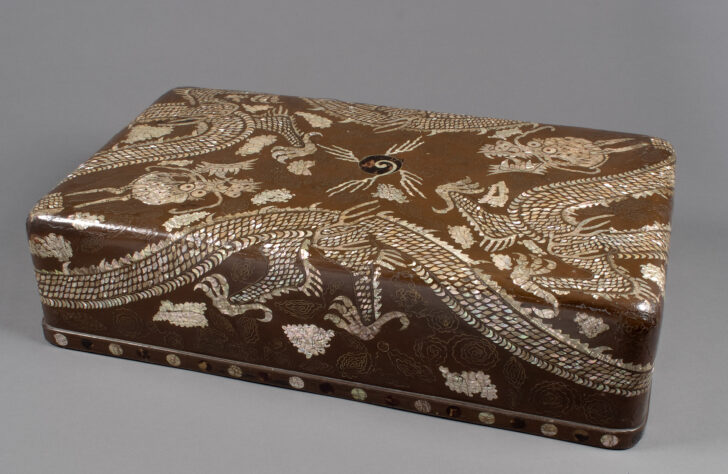Box with Double-Dragon Design
Korean

Description
Box with double-dragon design
Korea, Joseon dynasty (1392–1910)
ca. 1900
Lacquered wood with mother-of-pearl, tortoise shell,
and copper wire inlays
Gift of Linda Dresner Levy and Ed Levy, Jr., 2007/2.8
This box decorated with dragons would have been found
in a woman’s room, protecting the box’s contents and
owner, and expressing wishes for the successful careers
of the men associated with her. From at least the seventh
century, dragons were believed to govern the heavens
and the seas and to have the power to protect possessions
from enemies or evil spirits. The dragon was also one of
the Four Divine (Guardian) Animals associated with the
cardinal points of the compass. A painting of a dragon
(who guarded the east) was often paired with that of a
tiger (who guarded the west) on the entrance of a home
in order to dispel evil spirits and to bring good luck to
the family within. The term deung’yongmun (meaning
“gateway to a successful career”), refers to a heavenly gate
through which one passed to become a dragon.
Winter 2021 Gallery Rotation
__________
Box with double-dragon design
Korea, Joseon period (1392–1910)
ca. 1900
Lacquered wood with mother-of-pearl, tortoise shell, and copper wire inlays Gift of Linda Dresner Levy and Ed Levy, Jr., 2007/2.8
This box decorated with a dragon motif would also have been found in a woman’s room. From at least the seventh century, dragons were believed to govern the heavens and the seas and to the have the power to protect possessions from enemies or evil spirits. The dragon was also one of the Four Divine (Guardian) Animals associated with the cardinal points of the compass. Thus a painting of a dragon (who guarded the east) was often paired with that of a tiger (who guarded the west) on the entrance of a home in order to dispel evil spirits and to bring good luck to the family within. Dragons could also express hopes for a successful career, an important goal in the Joseon period—the term deung'yongmun meaning “gateway to a successful career,” refers to a heavenly gate through which one passed to become a dragon.
Subject Matter:
Box decorated with double-dragons reaching for cintamani (Buddhist wish-granting jewel).
Physical Description:
Lacquered wooden box with inlaid mother-of-pearl in double-dragon design. The heads of each dragon stretch diagonally inward from opposite corners of the box, with wide eyes and open mouths. Their bodies curve in and out of the top plane of the box, creating an opposing effect with symmetrical balance. The dragons reach forward towards a flaming orb in the center of the box, called a cintamani, or Buddhist wish-granting jewel. Among the dragons are swirling cloud designs made of inlaid nacre and copper wire.
The lid of the box completely covers the box from top to bottom. The box was used to store clothes. The design of the lid shows a pair of dragons arranged around cintāmaṇi at the center. The bottom edge of the lid is decorated with a row of dots. The dragons are rendered with mother-of-pearl. Cintāmaṇi in the middle of the lid is rendered with tortoiseshell. The row of dots was rendered alternately with mother-of-pearl and tortoiseshell. The outlines of the dragons’ bodies are rendered with twisted copper wire, while their whiskers are rendered with thin copper strings. The fabric that lines the interior is Japanese, which suggests that the previous owner was Japanese.
Usage Rights:
If you are interested in using an image for a publication, please visit https://umma.umich.edu/request-image/ for more information and to fill out the online Image Rights and Reproductions Request Form.